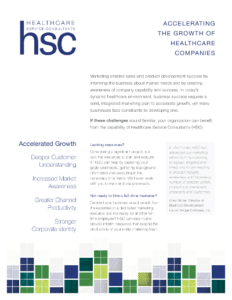
Why do people start companies? Because they know there is a problem they can solve. It is the very premise of the hit television series Shark Tank.
Yet, there’s often a key aspect that differentiates Shark Tank ideas that “make it” from ones that don’t. Those companies not only solve problems. They explicitly understand the context within which the problem exists.
The same holds true in the healthcare IT industry. If you want to introduce a new healthcare IT solution into a clinical environment, you must do more than “solve” a problem.
For instance, what is the clinical context of the problem? Does it impact a particular workflow or process that involves time, financial, or political considerations? Who else is out there solving the same problem or an adjacent problem?
This context determines who your target market is. It helps you answer questions like:
- Who is the buyer, and who carries direct influence on the buying decision?
- Who is your competition, and in what ways do you have a competitive advantage?
- How are purchase decisions made? What is the pathway from awareness to interest and procurement?
In this blog, we explore the importance of defining your buyer and influencer personas, as well as how to map their roles to the buyer journey.
Buyers vs. Influencers
When designing a product there are many different personas to consider:
- clinical personas (patients, front-line care providers)
- operational personas (departmental directors or managers, clinical applications specialists)
- technical personas (IT managers, systems administrators)
In marketing and selling a healthcare IT solution, we organize these personas into two main categories: buyers and influencers.
Buyers, as the name suggests, are personas who carry the authority to make a purchasing decision. Often, they are not actually the end users of most healthcare IT products. As such, it’s easy to forget about them when drafting your marketing strategy and messaging.
Buyer personas are often in leadership positions (CXO, Director, Chief). They generally have direct control over allocation of capital and operational finances. Marketing and selling to these personas requires the demonstration of a clear ROI surrounding efficiency, cost, or quality improvements to justify an investment.
Conversely, influencers do not always have full control of the budget. Rather, they are often the personas who are directly affected by the problem. They are also the potential end users of your product. While they do not have direct purchasing authority, influencers can weigh heavily on the purchasing decision. This is particularly true if they stand to benefit from it.
Marketing to these personas requires a deep understanding of the complete scope of problems each type of end user faces. These will vary from clinical, operational, financial, and technical perspectives. The value propositions and messaging need to address each unique angle. If you’re focusing too intently on your target user persona—and not considering the broader scope of your solution and how it fits in a healthcare organization—you may limit your success.
Mapping Out the Buyer Journey
Mapping out the buyer’s journey involves understanding the end-to-end process your prospective customers go through when making a purchase decision. It also includes identifying who is involved at each stage, what their unique motivations are, and any potential barriers they might face. The three main phases of a buying journey include:
1) Awareness
It’s best to assume problems are not well understood by all personas at this stage. In many cases, the buying process kicks off with an awareness campaign that educates target audiences about:
- problems they face
- negative impact those problems
- a possible solution (your products!)
Influencer personas are among the first audiences engaged at this point. Remember to consider the unique perspectives and needs of personas to generate broad awareness and build interest.
2) Consideration
At this point, buyer and influencer personas are aware of the problem and your solution. They are considering whether your solution is a good fit for their organization and workflow. They are also weighing if it will deliver sufficient value. This is where targeted messaging that communicates the unique value propositions of your solution—over the status quo or other competitive offerings—becomes increasingly important.
3) Purchase
This final phase is when the organization makes a purchasing decision—and awards a contract. Buyer and influencer personas are considering two or three possible solutions. Buyer personas typically take charge. A strong business case and ROI model, paired with competitive pricing, will help tip the scales in your favor.
In healthcare IT, the buying process can be lengthy, ranging anywhere from a few months to over a year. Mapping the touchpoints involving each persona, and their degree of influence at each phase, can help you tailor your marketing and sales efforts to engage with the correct audience more effectively at each step.
The quality and accuracy of your buyer’s journey map can mean the difference between generating revenue or losing time and resources to wasted sales and marketing efforts because of missteps during the buying process.
An Ongoing Process
Defining personas and mapping the buyer’s journey isn’t a “one and done” activity that ends upon launch. It needs to be revisited and revised to consider expanded reach, evolving market conditions, lessons learned, and a shifting competitive landscape.
Engaging with internal teams (product management, engineering, support, etc.) and external stakeholders (current or prospective customers), allows a strong healthcare IT product marketing leader to identify the problems, needs, and motivations of key buyer and influencer personas. It also helps maintain a buying process map that will help your sales team reach the final purchasing phase.
Are you interested in augmenting your understanding of your buyer and influencer personas and their role in the buyer’s journey? Our healthcare IT product marketing experts have a deep understanding of a wide variety of healthcare organizations and user profiles. Contact us to learn how we can help your organization.




